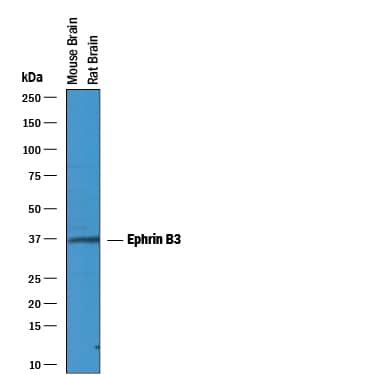Human Ephrin-B3 Antibody
R&D Systems, part of Bio-Techne | Catalog # AF395


Key Product Details
Species Reactivity
Validated:
Human
Cited:
Mouse, Rat
Applications
Validated:
Immunohistochemistry, Western Blot
Cited:
Flow Cytometry, Immunocytochemistry, Western Blot
Label
Unconjugated
Antibody Source
Polyclonal Goat IgG
Product Specifications
Immunogen
S. frugiperda insect ovarian cell line Sf 21-derived recombinant human Ephrin-B3
Leu28-Ser224
Accession # Q15768
Leu28-Ser224
Accession # Q15768
Specificity
Detects human Ephrin-B3 in direct ELISAs and Western blots. In direct ELISAs and Western blots, approximately 5% cross-reactivity with recombinant human Ephrin-A5 is observed.
Clonality
Polyclonal
Host
Goat
Isotype
IgG
Scientific Data Images for Human Ephrin-B3 Antibody
Detection of Mouse and Rat Ephrin-B3 by Western Blot.
Western blot shows lysates of mouse brain tissue and rat brain tissue. PVDF membrane was probed with 1 µg/mL of Goat Anti-Human Ephrin-B3 Antigen Affinity-purified Polyclonal Antibody (Catalog # AF395) followed by HRP-conjugated Anti-Goat IgG Secondary Antibody (Catalog # HAF019). A specific band was detected for Ephrin-B3 at approximately 36 kDa (as indicated). This experiment was conducted under reducing conditions and using Immunoblot Buffer Group 1.Applications for Human Ephrin-B3 Antibody
Application
Recommended Usage
Immunohistochemistry
5-15 µg/mL
Sample: Immersion fixed paraffin-embedded sections of rat embryo (E15) and rat brain
Sample: Immersion fixed paraffin-embedded sections of rat embryo (E15) and rat brain
Western Blot
1 µg/mL
Sample: Mouse brain tissue and rat brain tissue
Sample: Mouse brain tissue and rat brain tissue
Formulation, Preparation, and Storage
Purification
Antigen Affinity-purified
Reconstitution
Reconstitute at 0.2 mg/mL in sterile PBS. For liquid material, refer to CoA for concentration.
Formulation
Lyophilized from a 0.2 μm filtered solution in PBS with Trehalose. *Small pack size (SP) is supplied either lyophilized or as a 0.2 µm filtered solution in PBS.
Shipping
Lyophilized product is shipped at ambient temperature. Liquid small pack size (-SP) is shipped with polar packs. Upon receipt, store immediately at the temperature recommended below.
Stability & Storage
Use a manual defrost freezer and avoid repeated freeze-thaw cycles.
- 12 months from date of receipt, -20 to -70 °C as supplied.
- 1 month, 2 to 8 °C under sterile conditions after reconstitution.
- 6 months, -20 to -70 °C under sterile conditions after reconstitution.
Background: Ephrin-B3
References
- Eph Nomenclature Committee [letter]. Cell (1997) 90:403.
- Flanagan, J.G. and P. Vanderhaeghen (1998) Annu. Rev. Neurosci. 21:309.
- Pasquale, E.B. (1997) Curr. Opin. Cell Biol. 9:608.
Alternate Names
EFL-6, Efnb3, Elk-L3, EphrinB3, Epl8, LERK-8, NLERK-2
Gene Symbol
EFNB3
UniProt
Additional Ephrin-B3 Products
Product Documents for Human Ephrin-B3 Antibody
Product Specific Notices for Human Ephrin-B3 Antibody
For research use only
